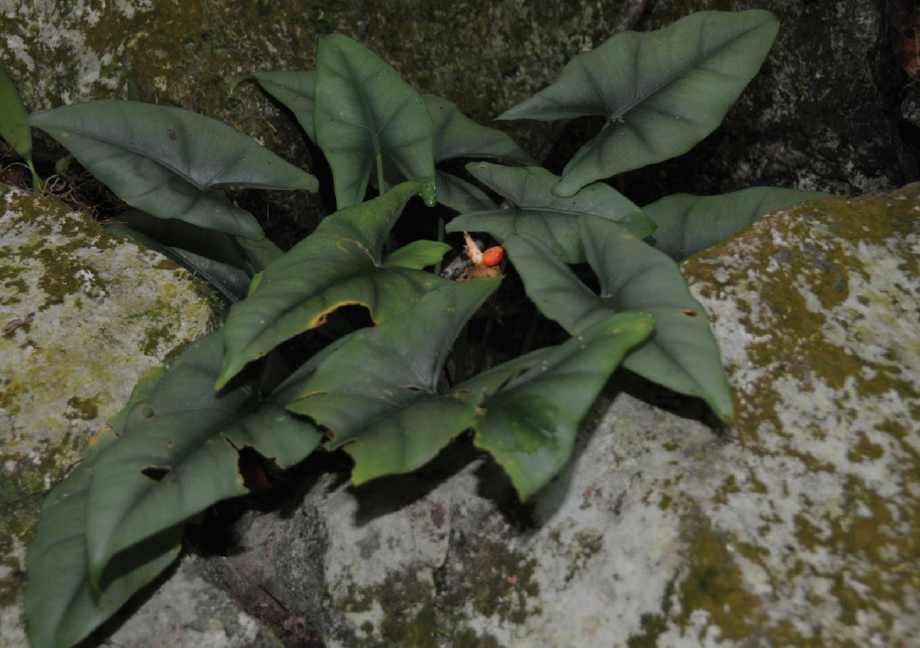ALOCASIA FARISII
ORIGINAL DESCRIPTION:
Alocasia farisii Zulhazman, Norzielawati & P. C. Boyce is described and illustrated from Karst limestone in Kelantan as the first recorded Peninsular Malaysian species of the hitherto wholly Bornean Alocasia princeps complex, within which Alocasia farisii most closely resembles the southwest Sarawak limestone-obligated Alocasia reversa, notably by the leaf blades adaxially grey-green and distinctly dark green about main veins and primary veins, and by having at least some plants with some or all of the leaf blades peltate, but differing by having staminate flower zone only half enclosed in the lower spathe chamber (vs staminate flower zone almost entirely enclosed), by ellipsoid (vs globose) lower spathe, by the spathe lacking a purple margin, and by fewer and less well-developed interstice synandrodes.
Type : Malaysia, Kelantan, Tanah Merah, Jentian Forest Reserve, ca 05 ° 29 ′ 14.5 ″ N, 102 ° 01 ′ 44.5 ″ E, 6 Jul 2011, Norzielawati S. UMK00190 (holotype: Herbarium, Faculty of Earth Science, Univ. Malaysia Kelantan).
Nordic Journal of Botany 000: 001–005, 2017
SYNONYMS: N/A
DISTRIBUTION: Peninsular Malaysia | Kelantan
Known only from the Karst limestone areas of Jentian (Tanah Merah, ca 05 ° 29 ′ 14.5 ″ N, 102 ° 01 ′ 44.5 ″ E), Gua Musang, and Gua Ikan – Gua Pagar (Kuala Krai, ca 05 ° 21 ′ 14.5 ″ N, 102 ° 01 ′ 35.3 ″ E), Kelantan, northeast Peninsular Malaysia
CLIMATE: Subtropical humid climate
Humidity is moderate throughout the year, ranging from 60% to 70%
Temperature is varies between the seasons - within the range of 48°F/9°C to 88°F/31°C during the day. Minimum temperatures never dip below 45°F/7°C
Rainy and humid season (October to May) and a dry season between June and October. The average annual rainfall is 1,200 mm
ECOLOGY: It grows as a lithophyte in soil and humus pockets on limestone outcrops and boulders, rather occasionally as terrestrial, on seasonally dry lightly forested Karst formations, 80 – 160 m a.s.l.
SPECIES DESCRIPTION:
Small epilithic, seldom terrestrial, mesophytic herb to ca 55 cm tall but mostly about half this height. Rhizome elongated, erect, later distally decumbent, ca 2.5 cm in diameter. Leaves several together, irregularly interspersed with semifleshy, later marcescent brown cataphylls to ca 7 cm long. Petioles ca 10 – 25 cm long, smooth, pale green, sheathing in the lower 1/3 – 1/2. Leaf blades thinly leathery; juvenile blades peltate with posterior lobes united for 60 – 90% of their length; on adult plants mostly all non-peltate, occasionally mixed peltate and non-peltate in some individuals, hastato-sagittate to slightly ovato-sagittate, 4 x 6 cm to 10 x 13 cm, glossy dark green along the midrib and primary veins adaxially, the remainder grey-green.
INFLORESCENCE:
Inflorescences 1 – 2 together, subtended by lanceolate membranous pale green, later marcescent brown, cataphylls; peduncle ca 7 – 13 cm long at anthesis, smooth, pale green; spathe ca 7 – 12 cm long; lower spathe ca 2 cm long, ovoid, creamy to very pale yellow; limb pale green at the tip, remainder creamy white, the colour extending into the constriction ventrally, at first erect, then sharply defl ected, oblong lanceolate, mucronate for ca 10 mm; spadix somewhat shorter than the spathe; stipe ca 3 mm, conical, green. Pistillate fl ower zone ca 0.7 cm long; pistils somewhat loosely packed, flask-shaped, facing obliquely upwards; style slender; stigma 2-lobed, white; interstice with 2 – 3 rows of pearl-like staminodes, these ca 3 mm in diameter, dull pale cream. Staminate flower zone ca 1.5 cm long, 4 mm in diameter, subcylindric, slightly constricted ca 1/3 from the base corresponding to spathe constriction; synandria rhombo-hexagonal ca 2.5 mm across, 4 – 6-merous, opening by apical pores; synconnective not expanded, ivory white; appendix roughly isodiametric with staminate flower zone, ca 2.5 cm long, gradually tapering to a blunt point, faintly longitudinally brain-like channelled, dull pale cream. Fruiting spathe broadly ovoid, ca 4 cm long; berries bright orange.
VARIEGATED FORMS: N/A
ETYMOLOGY: Alocasia farisii is named for HRH Tengku Mohammad Faris Petra Ibni Tengku Ismail Petra, now known as Sultan Mohamad V, the Sultan of the Malaysian State of Kelantan, in recognition of his great enthusiasm in conserving rare and endemic species in Kelantan.
NOTES:
The discovery of Alocasia farisii, a species belonging to an otherwise Bornean taxon complex, in Peninsular Malaysia, provides yet more indications of the close biogeographical relationship that exists for plants in northeast Malay Peninsular and Borneo, postulated as the “ Riau Pocket ” phytochore by Corner (1960), and elaborated by Ashton (2005) and Ahmad Sofiman and Boyce (2010).
CULTIVARS: N/A
HYBRIDS: N/A







